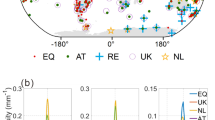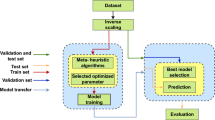Abstract
The position accuracy of GNSS is limited by several errors including multipath error. The multipath error is well known as one of the dominant error sources in most of the high-precision GNSS applications, as its fast-changing and site-dependent nature make it challenging to model and mitigate. The Non-Line-of-Sight (NLOS) signals in combination with the original Line-of-Sight (LOS) signal lead to multipath (MP), which results in erroneous range estimation. To mitigate the effect of multipath, detecting the presence of NLOS/multipath signals plays a vital role. In this paper, GPS and IRNSS signals are considered in simulated multipath environment and in open-sky conditions. A machine learning (ML) approach for classification of LOS/NLOS/multipath is presented in both the environments. In this paper, two classifiers are proposed. The proposed classifiers are trained with signal strength, elevation angle, Doppler shift, delta pseudorange, and pseudorange residuals as attributes. The accuracies of these models are computed and compared and it is found that, among all the algorithms, K-Nearest Neighbors, Decision Tree, and its ensemble functions have demonstrated superior performance. Experimental results are presented using GPS L1, IRNSS L5, and S1 data. A comparative analysis on both the classifiers is also presented. Further, to substantiate these results, another experiment is conducted in a complex real-time dynamic multipath environment and the obtained results are also presented.










Similar content being viewed by others
Data availability
The data used and analyzed during the current study are available from the corresponding author on reasonable request.
References
Mohd QJ, Achanta DS, Supraja RA, Sridher T, Nalam VKR, Pant TK (2018) Multipath and thermal noise free relative TEC estimation using IRNSS L5 and S1 signals. In: Proc. of int. conf. on innovative technologies in engineering, ICITE-2018, 11–13 Apr. 2018, Hyderabad, India. https://doi.org/10.3103/S0735272718070038
Misra P, Enge P (2002) Global positioning system: signals, measurements & performance. IEEE Aerosp Electron Syst Mag 17(10):36–37
ISRO IRNSS-ICD-SPS-1.0 (2014) IRNSS signal in space ICD for standard positioning service v. 1.0. Indian Space Research Organization (ISRO), Bangalore
Ghosh U, Sarma AD, Javeed MQ, Koteswara Rao NV (2017) Selective suppression of IRNSS S-band signals for specific applications. In: IEEE international WIE conference on electrical and computer engineering (WIECON-ECE), WIT, Dehradun, India. https://doi.org/10.1109/WIECON-ECE.2017.8468869
Kamatham Y, Achanta D, Kumar A, Satyanarayana K (2013) Spectral analysis and mitigation of GPS multipath error using digital filtering for static applications. IETE J Res 59:156. https://doi.org/10.4103/0377-2063.113036
Yedukondalu K, Sarma AD, Satya Srinivas V (2009) Multipath mitigation using LMS adaptive filtering for GPS applications. In: Applied electromagnetics conference (AEMC-2009), Kolkata, India. https://doi.org/10.1109/AEMC.2009.5430568
Yedukondalu K, Sarma AD, Satya Srinivas V (2007) Estimation and mitigation of GPS multipath interference using adaptive filtering. J Prog Electromagn Res-M (PIER M) USA 21:133–148. https://doi.org/10.2528/PIERM11080811
Kamatham Y, Sarma AD, Kumar A (2010) Mitigation of GPS multipath error using recursive least squares adaptive filtering. In: IEEE Asia Pacific conference on circuits and systems, pp 104–107. https://doi.org/10.1109/APCCAS.2010.5775022
Marais J, Berbineau M, Heddebaut M (2005) Land mobile GNSS availability and multipath evaluation tool. IEEE Trans Veh Technol 54(5):1697–1704. https://doi.org/10.1109/TVT.2005.853461
Yozevitch R, Moshe BB, Weissman A (2016) A robust GNSS LOS/NLOS signal classifier. NAVIGATION J Inst Navig. https://doi.org/10.1002/navi.166
Hsu L-T (2017). GNSS multipath detection using a machine learning approach. IEEE 20th international conference on intelligent transportation systems (ITSC), https://doi.org/10.1109/ITSC.2017.8317700
Xu H, Zhang G, Xu B, Hsu LT (2018) GNSS shadow matching based on intelligent LOS/NLOS classifier. In: The 16th world congress of the international association of institutes of navigation (IAIN, Chiba, Japan)
Suzuki T (2018) Mobile robot localization with GNSS multipath detection using pseudorange residuals. Adv Robot Symposia (Toyama, Japan). https://doi.org/10.1080/01691864.2019.1619622
Liu H, Li X, Ge L, Rizos C, Wang F (2011) Variable length LMS adaptive filter for carrier phase multipath Mitigation. GPS Solut 15:29–38. https://doi.org/10.1007/s10291-010-0165-9
Kubo N, Kikuchi R, Higuchi M (2015). A unique approach to strong multipath mitigation in dense urban areas. In: Proceedings of ION GNSS+ 2015, Tampa, Florida, pp 2905–2913
Ammana SR, Sujimol MR, Songala KK et al (2022) Advantage of IRNSS S-band signal for GBAS applications in adverse ionospheric storm conditions. Aerosp Syst AS 5:615–624. https://doi.org/10.1007/s42401-022-00158-6
Vemuri SS, Sarma AD, Reddy AS, Reddy DK (2014) Investigation of the effect of ionospheric gradients on GPS signals in the context of LAAS. Prog Electromagn Res B 57:191–205. https://doi.org/10.2528/PIERB13101305
Wang H-S, Kao C-Y, Chen J-F (2013) Sequential quadratic method for GPS NLOS positioning in urban canyon environments. Int J Autom Smart Technol 3(1):37–46. https://doi.org/10.5875/ausmt.v3i1.166
Sony D, Reddy DK, Kumar PN (2022) Implementation of receiver autonomous integrity algorithm for fault detection of IRNSS. Aerosp Syst AS 5:635–642. https://doi.org/10.1007/s42401-022-00161-x
Phan Q-H, Tan S-L, McLoughlin I (2013) GPS multipath mitigation: a nonlinear regression approach. GPS Solut J 17(3):371–380
Aweda F, Adebayo S, Ojedokun I, Olapade O (2022) Refractive index perception and prediction of radio wave through recursive neural networks. Int J Eng. https://doi.org/10.5829/ije.2022.35.04A.21
Wymeersch H, Marano S, Gifford WM, Win MZ (2012) A machine learning approach to ranging error mitigation for UWB localization. IEEE Trans Commun 60(6):1719–1728. https://doi.org/10.1109/TCOMM.2012.042712.110035
Cristianini ST (2000) An introduction to support vector machines and other kernel-based learning methods. Cambridge University Press, Cambridge. https://doi.org/10.1017/CBO9780511801389.008
Acknowledgements
The work presented in this paper is carried out under the project entitled “A New Model for Short Term Forecasting of Scintillations using Machine Learning Approach and Generation of Regional Scintillation Maps” sponsored by Department of Science and Technology under SERB-CRG scheme, vide sanction letter no: CRG/2021/001660, dated: February 11, 2022. The authors are also thankful to Space Applications Centre (SAC), ISRO Ahmedabad for providing AIGS Receiver for field trails under an MoU.
Funding
The research presented in this paper is carried out under the sponsored project funded by the Department of Science and Technology (DST), New Delhi, Govt. of India. However, there is no funding for publication processing fee under this project.
Author information
Authors and Affiliations
Corresponding author
Ethics declarations
Conflict of interest
The authors declare that they have no known competing interests.
Appendix-A
Appendix-A
1.1 Salient features of prominent supervised classification machine learning (ML) algorithms
The following is the brief introduction to all the supervised ML algorithms implemented in this research:
Logistic Regression (LR) Logistic Regression stands as a foundational linear model renowned for its application in binary classification tasks. It estimates the probability of an instance belonging to a specific class, relying on a linear combination of features.
LR with K-fold cross-validation Integrating Logistic Regression with K-fold cross-validation augments its reliability by systematically dividing the dataset into ten subsets. The model undergoes training on nine subsets while validating on the remaining one in a cyclical manner. This rigorous approach enhances the model's generalization performance, providing a robust estimate of its capabilities. In this research, a tenfold cross-validation is employed.
Naïve Bayes Naïve Bayes, a probabilistic classification algorithm grounded in Bayes' theorem, retains its appeal despite its assumption of feature independence. Its simplicity is particularly advantageous in various applications, such as classification problems, where it often outperforms more complex models.
K-Nearest Neighbors K-Nearest Neighbors (KNN), an instance-based algorithm, classifies data points based on the majority class among their three nearest neighbors. This approach proves flexible and effective, especially in scenarios where local patterns play a crucial role, although it may be sensitive to outliers. In this research K = 3 is considered and analyzed.
Support Vector Machine (SVM)—linear Linear Support Vector Machines seek to identify the optimal hyperplane that separates classes in binary classification problems. While effective for linearly separable data, SVM's true power emerges when combined with non-linear kernels, allowing it to capture intricate relationships in more complex datasets.
SVM with K-fold cross-validation Utilizing Support Vector Machines with K-fold cross-validation extends the model evaluation process, offering a more comprehensive assessment of its generalization performance. Through iterative training and testing across K different subsets of the data, the model's robustness and reliability are thoroughly examined. In this research, K = 20 is chosen and the same is analyzed.
SVM with kernels Enhancing SVM with non-linear kernels, such as Sigmoid, Polynomial, and Radial Basis Function (RBF), empowers it to handle non-linear datasets by transforming the input space. The choice of kernel type depends on the underlying characteristics of the data, allowing for flexibility and adaptability to diverse problem domains.
Decision Tree (DT) Decision Trees are intuitive models that make decisions by recursively partitioning the data based on feature values. While they offer interpretability and the ability to model complex relationships, they may be prone to overfitting, especially in situations with noise or outliers.
DT with ensemble functions (Voting, Random forest, Bagging, AdaBoost) Decision Tree ensembles, including Voting, Random forest, Bagging, and AdaBoost, address the limitations of individual trees. These ensemble methods combine or modify multiple Decision Trees to enhance overall predictive performance, offering robustness and adaptability across various data scenarios.
Rights and permissions
Springer Nature or its licensor (e.g. a society or other partner) holds exclusive rights to this article under a publishing agreement with the author(s) or other rightsholder(s); author self-archiving of the accepted manuscript version of this article is solely governed by the terms of such publishing agreement and applicable law.
About this article
Cite this article
Koiloth, S.R.S.J., Achanta, D.S. & Koppireddi, P.R. ML-based LOS/NLOS/multipath signal classifiers for GNSS in simulated multipath environment. AS (2023). https://doi.org/10.1007/s42401-023-00255-0
Received:
Revised:
Accepted:
Published:
DOI: https://doi.org/10.1007/s42401-023-00255-0




